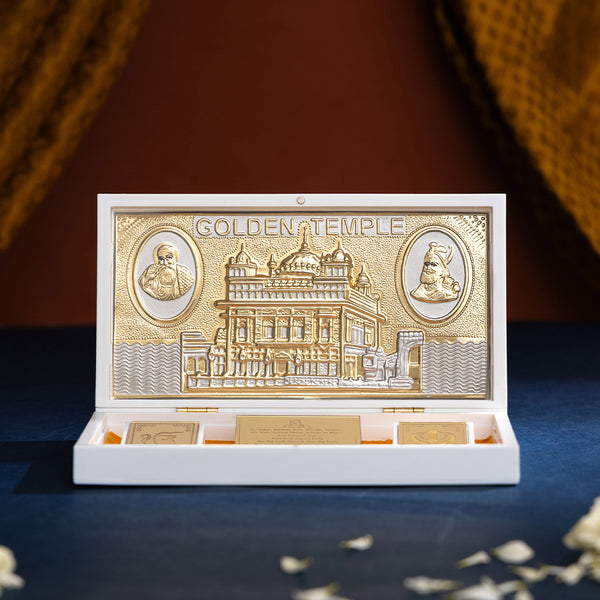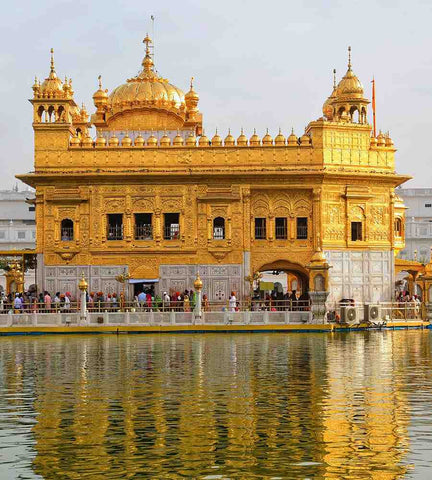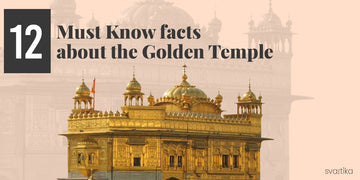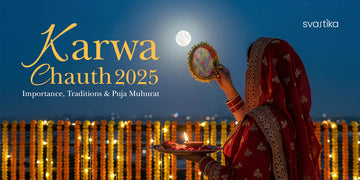A pilgrimage favorite, India’s Golden Temple remains to be one of the most visited spots in the whole of our country.
With beautiful architecture and wondrous ambiance, the Golden Temple is hailed for its charm and beauty. No pilgrimage or yatra is ever complete without a trip to the Golden Temple.
The Golden Temple, which is located in the heart of Amritsar, is the most respected Gurudwara in the country. The Golden Temple, also known as Sri Harmandir Sahib, stands for excellence, equality, and peace.
Due to Sri Harmandir Sahib's tremendous significance in Punjab's rich history, it is regarded as the most sacred Sikh pilgrimage site.
In Punjab, India, on a holy lake stands the Harmandir Sahib, the most revered location in Sikhism. Its name in English is The Golden Temple.
The Golden Temple in Amritsar is the most venerated of all Sikh holy sites.

Svastika Golden Temple Pocket Temple - Gold Plated
Intriguing Facts About Golden Temple that You Need to Know
1. Construction Started in the 16th Century
The location was formerly a tiny, antiquated lake in a peaceful forest where Buddha is reputed to have spent time. The Sikh religion's founder, Guru Nanak (1469–1539), thereafter began frequenting this place of reflection.
Following his passing, his devotees kept coming to the location, which eventually became the Sikhs' primary sacred shrine. The lake was both constrained and enlarged by Sikh Gurus over time.
The Hari Mandir, also known as the Temple of God since Hari is God, was later built by Guru Ramdas Sahib, the fourth of ten Sikh gurus, in the 1500s.
The building process began in 1581 and took about 8 years to complete. From the past to the present, the history of the Golden Temple is worth knowing about.
2. Baba Deep Singh Passed Away in the Golden Temple
One of the most revered martyrs in Indian history is Baba Deep Singh. He made a commitment to breathe his last at Sri Harmandir Sahib. With 5,000 soldiers, Baba Deep Singh fought the Jahan Khan invasion of Amritsar in 1757.
His head was severed from his body during the bloody struggle. He bravely battled the adversaries while holding his head in one hand in order to enter the shrine and pass away there.
3. It is Named the Golden Temple Due to the Gold

The English name of the Golden Temple—which is devoted to Hari (God)—comes from the fact that its top levels are covered in 750 kilograms of pure gold.
The four entry domes and the two-story sanctuary both have domes covered in gold leaf. It appears magnificent, especially when the sun's rays reflect off of it.
The outer covering of gold foil that covers the entire temple gave rise to the name "Golden Temple.".
Although nearly impossible to experience such magnificence without actually visiting the sacred site, you can keep a miniature pocket golden temple close just for the essence of it.
This Gurudwara was often assaulted and destroyed by the Islamic rulers after the passing of Guru Govind Singh. This holy legacy was completely destroyed by gunpowder in the year 1762.
After the destruction, a courageous Sikh king named Maharaja Ranjit Singh repaired the valuable legacy with marble and embellished it using gold.
4. Lord Buddha Stayed at the Golden Temple Site
The location was formerly a tiny, antiquated lake in a peaceful forest where Buddha is reputed to have spent time. The Sikh religion's founder, Guru Nanak (1469–1539), thereafter began frequenting this place of reflection.
Following his passing, his devotees kept coming to the location, which eventually became the Sikhs' primary sacred shrine.
Records indicate that Lord Buddha spent a significant amount of time at the Golden Temple.
The location back then was a lake surrounded by dense trees. Buddha proclaimed this location to be the best place for saints and sadhus to meditate.
5. It is surrounded by Amrit Sarovar
The city's name derives from the old lake, which was known as the Amrita Saras or "pool of ambrosial nectar." The name of the temple complex is Amritsar as well.
Sikhs can take baths in the pool from the outside platform because they regard it as holy and purifying. You can observe temple employees filling buckets of water for worshippers while you are there.
6. Its First Floor is Below the Ground Level
Only during kar sewa is the first floor of the temple visible because it is submerged in the Amrit Sarovar otherwise. The stairs leading to the shrine descend because the Golden Temple is unusually constructed at a lower level below the surface of the earth.
Contrary to this, Hindu temples are always constructed on a raised platform above the ground. This distinctive Golden Temple feature denotes modest life.
7. People from all Religions and Castes are Welcome there
Mian Mir, a well-known Sufi saint, laid the foundation stone for the fortunate Golden Temple. This was done to demonstrate that individuals of various faiths can visit this famous Gurudwara.
Four doors show the temple's acceptance of all worshippers, regardless of caste, creed, or religion.
8. Largest Free Kitchen in the World

The Langar Sewa of the Amritsar Golden Temple houses the biggest free kitchen in the entire globe. There are given more than 50,000 meals each day. The figure rises to at least one lakh on holy occasion days.
The meal is simple but delicious and comprises of rotis, dal, vegetables, and kheer. It's noteworthy that every meal served here is provided by followers.
9. People do Volunteer Work at the Golden Temple

Millions of worshippers visit the fabled Golden Temple each month. The only source of funding for the upkeep and operation of this renowned gurudwara is donations.
However, the volunteers who perform unpaid work at the shrine are in charge of the regular tasks of cooking, cleaning, and serving food.
10. It was Renovated in 1995
In the 1990s, 500 kg of pure gold was used to refurbish the famous Golden Temple. During the procedure, 24-karat gold was used, which is significantly purer than 22-karat.
At this time, the gold is worth more than 130 crores. The work was completed by talented painters from all around India. The reconstruction took four years to complete, from 1995 to 1999.
11. It is a Unique Blend of Mughal and Hindu Architecture
Weaving between Mughal and Hindu architecture seamlessly, the Golden Temple is revered for its beautiful and majestic build. Marble paintings and sculptures that resemble the Taj Mahal embellish the mausoleum.
The gurudwara is covered in exquisite gold panels and has a pure gold dome at the top. Gold and priceless stones are used to decorate the ceiling as well.
12. Guru Granth Sahib Scripture is present in the Golden Temple
The Guru Granth Sahib, the primary holy religious text of Sikhism, is located inside the Temple on a platform covered in jewels.
A compilation of poems, prayers, and hymns written by the 10 Sikh gurus, as well as numerous Muslim and Hindu saints, make up the sacred text.
An architectural splendor and cultural marvel, a trip to the Golden Temple is a must-need to purge your body and soul and discover the inner meaning of life.








